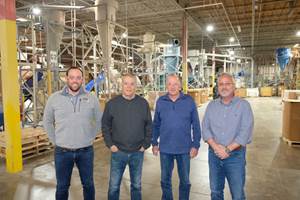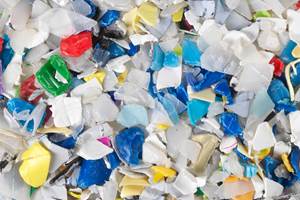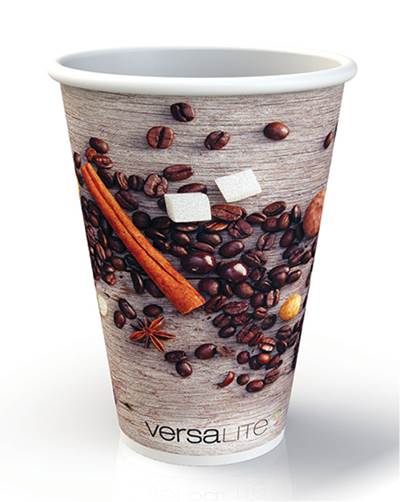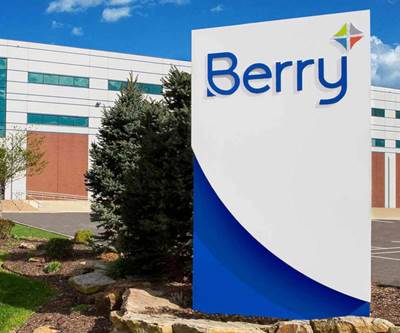The sheer size of Berry Global—290 manufacturing locations; 50,000 employees; 25,000 customers; operations in six continents—lends outsized weight and influence to any of its actions. That sway has been a force for good in the push for sustainability within packaging where it has made aggressive moves to reduce the environmental impact of the plastic goods it produces.
According to the company’s 2019 Impact report, Berry set a new record for annual usage of post-consumer plastic last year, purchasing more than 70,000 metric tons (approximately 154 million lb) of recycled plastic for use in its products. That figure doesn’t include its use of its own in-house post-industrial scrap.
In 2020, Berry launched a new line of stock PCR closures utilizing curbside material, describing the series as the most comprehensive portfolio of sizes and styles in the industry. The company said it eventually plans to introduce a portfolio with over 30 items/variations. At this time, there are various non-food closures approved in overcaps, continuous thread, dispensing/flip-top, tamper-evident and cups. Berry has also added jars to its portfolio of PCR products.

Berry has boosted the used of recycled content and moved to make its packages more recyclable to help meet its sustailability goals.
Berry is not alone in setting and sharing sustainability goals. Sustainability consulting organization Governance & Accountability Institute Inc. (G&A; New York) announced in July that its just completed 2020 research showed that 90% of S&P 500 companies published a sustainability report in 2019. Simply stated, the world’s biggest companies are looking to green up their act and asking their supply chains to help them do just that.
Plastics Technology spoke with Brian Hunt, executive vice president and general manager at Berry Global, about the company’s efforts in light weighting and recycling, as well as the broader market push for these activities.
Q: If you go to the store and grab a bottle of water, you notice that caps are getting smaller—how much of a point of emphasis has that been as part of sustainability efforts for Berry, just in terms of reducing the amount of material used?
A: It’s actually been a huge focus of Berry’s, not only in caps and closures, but all of our rigids, including containers and cups.
What we’re doing and endeavoring to do on the caps and closure side is use some of our learnings from other rigids—containers and cups—to push the limits within the bounds of functionality to further lightweight our caps and closures.
The two primary pillars of our approach have been light weighting and focusing on recyclable materials.
One of the closure families that come to mind are wide-mouth continuous thread closures that we recently launched. We took 25% of the gram weight out of the vintage that we innovated. That was pretty significant.
That was a long answer to your question, but historically it’s been a huge focus. The two primary pillars of our approach have been light weighting and focusing on recyclable materials.
In terms of achieving weight savings, obviously there’s the design element and testing that out in simulation to make sure it’s functional. In terms of machine innovation, and/or material innovation, did those play a role?
It’s a portfolio of a few things, but certainly material science is integral to achieving maximum light weighting while staying within the bounds of functionality and making sure the part can perform in the customer’s application.
Beyond the material science, we have extensive internal capabilities in mold building and so we’re leveraging all of those internal capabilities regarding mold technology in combination with that material science to be able to deliver a part which can still perform.
We partner with our injection molding machine vendors to deliver any custom specifications, in terms of of the tonnage or the screw and barrel design, what have you. So that portfolio really comes together to achieve the solution.
Another thing I would add that I think might be unique to Berry, we have a broad portfolio of machine partners, but we have the internal expertise to pull in different componentry and then finalize that primary and secondary process manufacturing line to ultimately create the solution.
When you go with reductions like this, is there any impact on the cavitation of the tooling?
It is still quite high. Our general approach, and this goes back into history as well, is using manufacturing scale to achieve cost leadership in the industry. We do generally focus on high-cavitation molds in caps and closures, and those are generally two-level molds as well.
In blow molding, machinery suppliers would tout lighter and lighter water bottles, to the point that it became a joke that eventually the bottle will get so thin it’s just a bag, but in closures, how much more weight savings could be achieved or have we hit an upper limit?
I think it’s fair to say that for some of our most recent innovations, we are pushing the limit of how lightweight a closure can be and still function properly, but there’s more opportunity there. One of the challenges I offer up to the broader industry is let’s work together to take 10% of the weight out of the broader portfolio of the market of caps and closures. My own mental math suggested that might be as much as 100 million lb of material that we could take out of the marketplace, which is considerable.
Let’s work together to take 10% of the weight out of the broader portfolio of the market of caps and closures. My own mental math suggested that might be as much as 100 million lb of material.
If you combine that with using material that’s recyclable, that’s a big sustainability impact in terms of material not entering the market. Material that can potentially be reused as post consumer material and then when you add to that the greenhouse gas reduction; I think it’s a significant sustainability story.
In the past, there have been some issues in establishing a robust recycling stream for polypropylene, how has that impacted your materials portfolio? Are you more reliant on a PE; are certain PE’s more difficult to recycle?
I wouldn’t say that they have the same level of recyclability because decoration with inks would be one of the immediate impacts that might prohibit ease of recycling of any material stream. I think polyethylene is more plentiful, generally, as a post consumer—there are so many sources—milk jugs for example.
For caps and closures, I am more focused on PP. As you noted, that’s a little bit more of a challenge as we really seek to build the sources of PP post-consumer materials.
For the portfolio of closures Berry did announce, I feel like we do have a good steady stream of curbside sourced material that offers reasonably good quality. Certainly good enough that I feel like the stream is going to be consistent, such that we could announce such a portfolio to the broader marketplace and be confident that that stream could continue.
Trying to identify streams of recycled material to promote lines with post consumer seems like it’s always a difficult challenge, ensuring you have a steady stream of material and committing to a certain level of production for your customers. What does that market look like today? Is it growing, are you encouraged?
I actually would say I am encouraged, just by virtue of the fact that the demand of our customers, the customers of the broader converter market, is increasing. Many large consumer packaged goods companies have made a very public commitment on sustainability and specifically an effort to introduce more post consumer material into their packaging.
Many large consumer packaged goods companies have made a very public commitment on sustainability and specifically an effort to introduce more post consumer material into their packaging.
So by virtue of that very public signaling of increased demand there’s more activity in the market, and we’re able to broaden then and engage with more partners, and I think more streams are beginning to come online so we have some legacy recyclers that have been participating in the marketplace and providing post-consumer material.
For those, their quality seems to be getting even better than perhaps it once was and then there are more folks entering the market as demand increases, so I actually am very bullish that we’re going to continue to see increased participation in mechanical recycling, with ever more high quality streams. Then of course, we’re all reading about investments that chemicals companies are making in their chemical recycling efforts, which ultimately might provide a source of post-consumer material that’s closest to virgin material, which is what I think we all want to try to achieve.
Post industrial or inhouse scrap, what does that look like at Berry? Are you able to capture a lot of that?
We absolutely do have post industrial, and I would venture to say we’re probably capturing and reusing more than 95% of it. I’m speaking broadly in rigids, not just in caps and closures, but we’re reusing all of it, and we’re very efficient in its reuse. Whether it’s blank or it has inks, we can sandwich it between two layers in some cases, especially when it’s say a home care use or maybe a more industrial use like a pail. We have opportunity to integrate post industrial. So it’s very high reuse and we have very little ultimate scrap rate.
In house handling of post consumer material, what does that look like from a material handling standpoint, did you have to make any changes to your process or systems or layout to accommodate post consumer scrap?
The simple answer is yes—we did make some accommodations on the lines and the layout of the lines, especially here at our corporate headquarters, which also is the location of our flagship manufacturing plant, our largest one. We do injection molding here as well as thermoforming and for the thermoforming lines, especially, to accommodate the introduction of post industrial so we have separate holding facilities and in some cases we have a pelletizer to repelletize product in a couple of plants. We have a pretty sophisticated setup in our thermoforming lines to introduce the post industrial.
Berry recently launched a series of new closures and jars containing post consumer resin, can you give an overview of the markets they’re in, maybe markets they can’t be in yet: food-contact issues, FDA approval, hot fill product?
Well the desire is certainly to expand them because our initial focus is going to be in the personal care and home care spaces so not food contact. This is curbside material so while it is of consistent quality, I would describe it as lower quality mixed scrap. So this is not approved for food contact, necessarily. That’s why we’re focused initially on personal care and home care products, and then, as we seek to add more higher quality sources, ultimately I think we certainly want to have food-contact capability for PCR, absolutely, but I would describe that as an aspirational goal sometime in the future.
Some of our larger personal care and home care customers have said specifically, ‘We need closures with more post consumer content.’
So we’re launching up to 30 items/variations in this portfolio initially, just in black, for personal care and home care use, primarily. As we look ahead into next year, we feel confident that we can add multiple colors, and we’ll continue building and expanding the served markets as we’re able to.
Berry has shown some initiative here, taken it on itself, have you gotten inquiries about recycled content from your customers? Is this something they’ve stressed to you as a vendor to make possible?
We have actually, I would describe us, just generally, as being a market leader in terms of our innovation, and we’re definitely a market-facing organization. So as we go out into the market and continue to go out into the market, this is certainly a request, a demand that we see in the market place.
Some of our larger personal care and home care customers have said specifically, ‘We need closures with more post-consumer content,’ and you know we won’t be happy, nor will they be, to just rest at 25%. We’ll continue to push the envelope and most of those percentages up as the quality of the post consumer material stream continues to improve.
In the U.S., collection of recycling is kind of a hodge podge, are there things, from Berry’s perspective, that you think would help create a more reliable stream of that material for you?
The first thing that comes to my mind if we can ensure, all of us that participate in the market, that we’re adhering to the APR (Assn. of Plastics Recyclers) design guidelines for packaging, because if we’re doing so we’re giving the best opportunity for any plastic package to reenter the stream. We’re making sure that we’re making those packages with, first and foremost, raw materials that are recyclable. They’re meeting the other guidelines in terms of size or color or decoration types. It has to be able to be recycled, first and foremost. That’s what’s at the top of my mind; making sure we’re adhering to that.
It’s an emotional issue. Sometimes in those discussions when emotion is involved supplying a bunch of facts doesn’t really work so well.
There’s a lot of pressure on the plastics industry, especially around single-use plastics, does more of a conversation need to be had or more public awareness of efforts like yours to let the public know the industry is aware of the situation and working on it? Brandowners have stepped up and played up the use of recycled content; from your perspective is there an opportunity to educate the public more about what the industry is trying to do?
I think there’s always an opportunity to come together and have the dialogue, which would include fact-based education. In addition, it’s an emotional issue. Sometimes in those discussions when emotion is involved, supplying a bunch of facts doesn’t really work so well.
The reality is the constituency—the broader market and Berry—we all want the same thing, which is to reduce plastic waste and ensure that plastic packaging gets recycled and reused. That’s the one thing we’re always going to have in common, and that’s why the dialogue, I think, can always be fruitful because whether we’re approaching it from a lightweighting perspective or making sure we’re using recyclable material, less plastic means less waste. Making it recyclable means it has the best chance to reenter the stream and be reused, which is what we all want.

Berry Global’s Executive VP and General Manager Brian Hunt .
Related Content
Multilayer Solutions to Challenges in Blow Molding with PCR
For extrusion blow molders, challenges of price and availability of postconsumer recycled resins can be addressed with a variety of multilayer technologies, which also offer solutions to issues with color, processability, mechanical properties and chemical migration in PCR materials.
Read MoreEvolving Opportunities for Ambitious Plastics Recycler
St. Joseph Plastics grew from a simple grinding operation and now pursues growing markets in recycled PP, food-grade recycled materials, and customized post-industrial and post-consumer compounds.
Read MoreFoam-Core Multilayer Blow Molding: How It’s Done
Learn here how to take advantage of new lightweighting and recycle utilization opportunities in consumer packaging, thanks to a collaboration of leaders in microcellular foaming and multilayer head design.
Read MoreLooking to Run PCR on a Single Screw? Here’s What to Keep in Mind
Just drop it in and mix it up? Sorry, there’s a lot more to it than that. Here is some of what you need to consider.
Read MoreRead Next
PP Cup Billed as Alternative to PS Foam
Cellular structure is created during the sheet extrusion process using atmospheric gas.
Read MoreBerry Global and Georgia-Pacific Announce Recycling Partnership
Through this agreement, the companies will partner across the multiple steps of the material supply chain to create a stream of PCR.
Read More





























